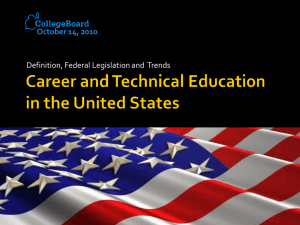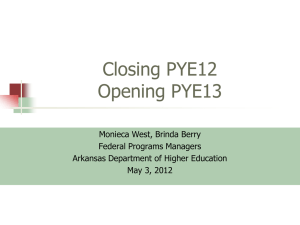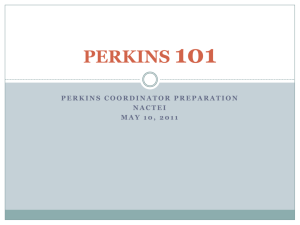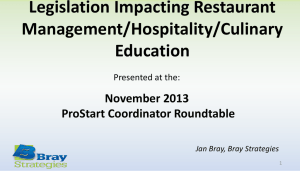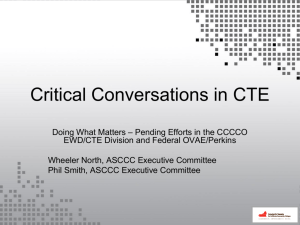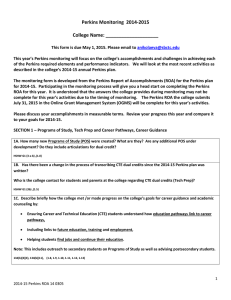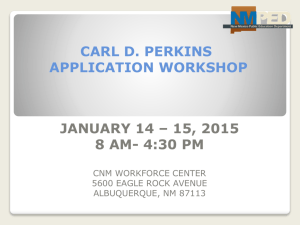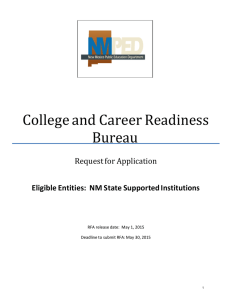Perkins 101 - Perkins Coordinator preparation
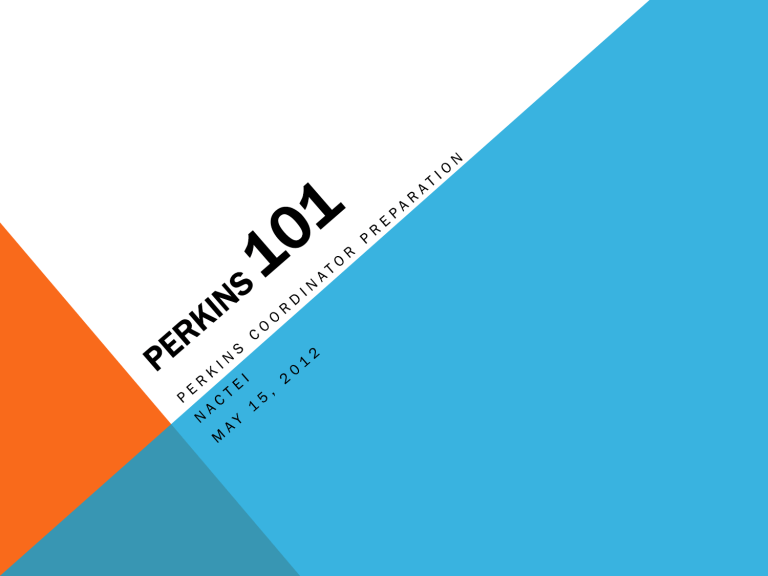
CARL DEWEY PERKINS
Representative from Kentucky
1949-1984
Legacy of support to education and the underprivileged
Perkins Student Loan
Carl D Perkins CTE Program
EVOLUTION OF PERKINS PROGRAM
1905: Advocates for “practical education” argue for broader public school curriculum that prepares graduates for jobs
1917: Smith-Hughes Vocational Education Act ($1.7M)
1936: George-Deen Act increased funding ($14.5M)
1968:Replacement legislation introduced by Rep. Perkins ($365M)
1984: Perkins I-vocational education improvement, special pops
1990: Perkins II-integration of vocational and academic education
1998: Perkins III-technology and workforce preparation
2006: Perkins IV-local accountability, increased academic preparation; preparation for high wage, high skill occupations for tomorrow’s workforce
2011: Elimination of Tech Prep funding and future implications
2012: Release of A Blueprint for Transforming Career and Technical Education
PURPOSE OF PERKINS PROGRAM
Develop more fully the academic, vocational and technical skills of students enrolled in CTE:
Develop challenging and rigorous academic and technical standards so that students are prepare for high skill, high wage, high demand, and emerging occupations
Link secondary and postsecondary education for effective student transition
Develop, implement and improve CTE
Professional development and other activities that improve the quality of CTE teachers, faculty, administrators and counselors
Partnerships among educational institutions, state agencies, and business and industry
Provide lifelong learning opportunities that will produce the knowledge and skills needed to keep the U. S. competitive .
OVERSIGHT AND AUTHORITY
Federal
•U.S. Department of Education
•Office of Vocational and Adult Education
•Carl D. Perkins Act of 2006
State
•Eligible Agency
•Sole state agency responsible for administering program
•State Plan/Improvement Plan
Local
•Eligible Institution (postsecondary)
•Eligible Recipient (secondary)
•Local Plan/Annual Plan/Improvement Plan
DISTRIBUTION OF FUNDS
Consortia
$15,000 Secondary
$50,000 Postsecondary
Split of local funds between secondary and postsecondary determined by State
Eligible Agency and described in State
Plan
ROLE OF THE LOCAL COORDINATOR
Local
Institution
Local
Coordinator
State
Agency
USE OF FUNDS
L O C A L
Administration
5% of funds used
Program Improvement
Annual Budget
Required use of funds
Permissive use of funds
Improvement Plan
S T A T E
Administration
5% of funds used – must be matched
State Leadership
10% of funds used
Required use of funds
Permissive use of funds
Improvement plan
Reserve Funds
up to 10% of the 85%
Accountability Elements
(Postsecondary Example)
REQUIRED & PERMISSIVE USE OF FUNDS
SECTION 135. LOCAL USE OF FUNDS
REQUIRED
PERMISSIVE
Strengthen CTE through integration of academics and technical programs Involve stakeholders
Career guidance and academic counseling Link secondary and postsecondary through programs of study
Business partnerships All aspects of industry
Programs for special populations Develop, improve, or expand CTE
CTE student organizations Professional development
Mentoring and support services CTE evaluation
Equipment and instructional materials Initiate, improve, expand and modernize CTE programs, including technology
Teacher preparation
Activities for special populations
Accessibility of postsecondary instruction
Transition to baccalaureate
Entrepreneurship, family and consumer science, automotive
New courses
Career-themed learning communities
CTE for adults and dropouts to complete secondary or to upgrade skills
Career assistance
Activities for nontraditional fields
Pooling of funds
USE OF FUNDS
1. Core indicator improvement plan
2. Core indicators below overall target
3. Sub-populations performing lower than general population
4. Indicators supporting state CTE goals and objectives
5. Programs of greatest size and scope
6. Rigorous programs of study
7. General improvement of CTE programs
! ACTIVITIES THAT IMPROVE STUDENT OUTCOMES
APPLICATION PROCESS
Paper/Online
Development of Annual Budget
Submit/Approve or Reject/Spend or Resubmit
Must be in substantially approvable form by June 30 in order to spend funds on July 1 very important for salary based activities!!!
SAMPLE TIMELINE
April – Applications due for the next fiscal year
June – Final budget amendments for current fiscal year
June 30 – Final encumbrances for current fiscal year
July 1 – Applications must be substantially-approvable
Sept 30 – All encumbrances from previous fiscal year must be liquidated
Amendments are requested throughout the year as needed
November /December – Data available for analysis
January/February – Carryover allocations made available
March – Local boards approve applications for the next fiscal year
COMPLIANCE REVIEW
Program Fiscal
• Improvement
Plans
• Activity progress
• Interviews
• Professional development
• Reimbursements to date
• Remainder of year
• Planned amendments
• PARs
• Inventory check
• Random sample invoices
Accountability
• Core indicators
• Improvement plan
• Data quality
• Program of Study documentation
TECHNICAL ASSISTANCE OPPORTUNITY
5-STEP IMPROVEMENT PROCESS
STEP 1
Document
Performance Results
STEP 2
Identify
Root Causes
STEP 5
Implement
Solutions
Overall
Race
Gender
Special Pops
CIP
STEP 4
Pilot Test and
Evaluate
Best Solutions
STEP 3
Choose
Best Solutions
SANCTIONS
Typical steps toward sanctions
Year 1: Technical assistance and monitoring
Year 2: Directed use of funds
Year 3: Sanctions implemented
MAKE IT WORK!
Learn the timeline
Understand the core indicators
Understand fiscal responsibilities
Establish a local team; use them
Seek and participate in technical assistance provided by State staff
Organize electronic and paper files
Monitor and adjust
THANKS!
Randy Dean
Director, Grants Management
Office of Technical Education
Technical College System of Georgia rdean@tcsg.edu


